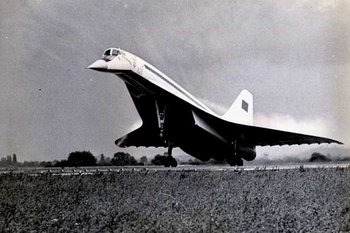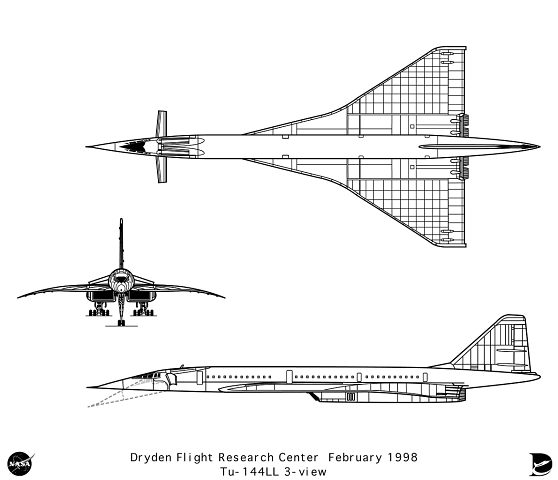Tupolev Tu-144
|
|
The Tupolev Tu-144 (NATO reporting name: Charger) was a supersonic airliner constructed under management of the Soviet Tupolev design bureau headed by Alexei Tupolev (1925-2001).
Western media nicknamed the plane Concordski (sometimes Konkordski), sounding like a Russian surname yet still very close to Concorde, to which Tu-144 bore superficial similarity. A prototype first flew on December 31, 1968 near Moscow, two months before the Concorde. The Tu-144 first broke the sound barrier on June 5, 1969, and on July 15, 1969, it became the first commercial transport to exceed Mach 2.
| Contents |
Development
The Tu-144 design owed much to industrial espionage, with the Aerospatiale's French factory proving particularly open to infiltration. When Sergei Pavlov -- officially head of Aeroflot's Paris office -- was finally arrested in 1965, he was in possession of details of Concorde's brakes, landing gear and airframe. However another agent, Sergei Fabiew, whose successes included obtaining the complete prototype blueprints, was not arrested until 1977.
While such espionage defined the basic shape of the plane and assisted considerably in its development, the 1970 Tu-144 prototype was far from a simple copy, and based on flight tests, considerable changes were made between the prototype and the Tu-144S pre-production model reg 77101.
At the Paris Air Show on June 3, 1973, the development program suffered a severe blow when the first Tu-144S production aircraft reg 77102 crashed. While in the air it undertook a violent turn down (allegedly to avoid a French Mirage fighter plane that was, apparently unknown to the Tu-144's crew, escorting it to photograph the SST's innovative canard wings). Trying to pull out of the subsequent dive, the plane broke up and crashed, destroying 15 houses and killing all six on board and eight on the ground. The French and Soviet governments colluded to cover up the incident; nonetheless, this was a black mark on the Tu-144's reputation.
Recent information released from archives shows that the black box was actually recovered to Russia and decoded. The cause of this accident is now thought to be due to changes made by the ground engineering team to the auto-stabilisation input controls prior to the second day of display flights. These changes were intended to allow Tu-144 to outperform Concorde in the display circuit. Unfortunately, the changes also inadvertently connected some factory-test wiring which resulted in an excessive rate of climb, leading to the stall and subsequent crash.
In service
The Tu-144S went into service on December 26, 1975, flying mail and freight between Moscow and Alma-Ata in preparation for passenger services, which commenced in November 1977 and ran a semi-scheduled service until the first Tu-144D experienced an in-flight failure during a pre-delivery test flight, and crash-landed with crew fatalities on May 23, 1978. The Aeroflot flight on June 1, 1978 would be the Tu-144's 55th and last scheduled passenger service.
A scheduled Aeroflot freight-only service recommenced using the new production variant Tu-144D aircraft on 23 June 1979, including longer routes from Moscow to Khabarovsk made possible by the more efficient RD-36-51 engines used in the Tu-144D version. Including the 55 passenger flights, there were 102 scheduled Aeroflot flights before retirement of commercial services.
It is known that Aeroflot still continued to fly the Tu-144D after the official end of service, with some additional non-scheduled flights through the 1980s. One last report showed that it was used on a flight from the Crimea to Kiev in 1987.
Production
A total of 16 airworthy Tu-144s were built: The prototype Tu-144 reg 68001, a pre-production Tu-144S reg 77101, nine production Tu-144S reg 77102-110, and five Tu-144D reg 77111-115. There was also at least one ground-test airframe constructed for static testing in parallel with the prototype 68001 development. The Tu-144S model had NK-144 turbofan engines, whereas the later Tu-144D model featured more powerful RD-36-51 engines with better fuel efficiency (particularly during supercruise, not requiring afterburner) and longer range.
Although its last commercial passenger flight was in 1978, production of the Tu-144 would not cease until six years later, in 1984 when construction of the partially complete Tu-144D reg 77116 airframe was stopped. During the 1980s, the last two production aircraft to fly were used for airborne laboratory testing, including research into ozone depletion at high altitudes. These two aircraft remain at the Tupolev production plant in Zhukovski, reg 77114 and 77115.
In 1990, Tupolev approached NASA and offered a Tu-144 as a testbed for its High Speed Commercial Research program, intended to design a second-generation supersonic jetliner. In 1995, Tu-144D reg 77114 built in 1981 (but with only 82 hours, 40 minutes total flight time) was taken out of storage and after extensive modification at a total cost of $350 million was designated the Tu-144LL. It made a total of 27 flights in 1996 and 1997. In 1999, the project was cancelled.
The Tu-144LL was reportedly sold in June 2001 for $11 million via online auction, but the plane did not sell after all - Tejavia reported on September 2003 that the deal was not signed. The replacement Kuznetsov NK-321 engines (from the Tupolev Tu-160 bomber) are military items. The Russian government would not allow them to be exported.
It should be noted that the original Tu-144 and Tu-144S equipped with the NK-144 turbofan engines could not cruise at Mach 2 without the afterburner on. A cruising speed of Mach 1.6 was possible. For the last research flights, the Testbed 144LL reg 77114 and the last remaining Tu-144D reg 77115 were under restriction to not exceed Mach 1.
Latest news is that one of the two planes has been sold to a Belgium museum and was shipped - not flown - there in 2004. The NK-321 jet engines were removed prior to export.
Specification (Tu-144S)
- Power source: 4 Kuznetsov NK-144 turbofans of 196 kN afterburning thrust
- Maximum cruising speed: 2,500 km/h (Mach 2.35)
- Operational ceiling: 18,000 m
- Range with maximum payload: 6,500 km
- Empty weight: 85,000 kg
- Maximum take-off weight: 180,000 kg
- Span: 28.80 m
- Length: 65.50 m
- Crew: 3
- Passengers: 120
- Wing area: 438 m²
External links
- TU-144 SST index (http://perso.wanadoo.es/tu144sst/index.html)
- Tupolev TU-144 page (http://www.tupolev.ru/English/Show.asp?SectionID=148)
- TU-144 discussion forum (http://p066.ezboard.com/ftupelevtu144forum5881frm2)
- TU-144 history overview (http://home.comcast.net/~yoshac/TU144/index.html)
- Auto + Technik Museum Sinsheim (http://www.technik-museum.de/)
- List of Tu-144s with eventual fate (http://www.moninoaviation.com/tu144sn.html)
- Full production list in Russian (http://www.testpilot.ru/russia/tupolev/144/s/tu144s_2.htm) and auto-translated to English (http://www.translate.ru/url/tran_url.asp?lang=ru&direction=65538&template=Default&autotranslate=&transliterate=true&url=http%3A%2F%2Fwww%2Etestpilot%2Eru%2Frussia%2Ftupolev%2F144%2Fs%2Ftu144s_2%2Ehtm)
- NASA video clip (http://www.dfrc.nasa.gov/Gallery/Movie/TU-144LL/)
Related content
Related development:
Comparable aircraft: Boeing 2707 - Concorde - Lockheed L-2000
Designation sequence: Tu-141 - Tu-142 - Tu-143 - Tu-144 - Tu-148 - Tu-154 - Tu-155
Related lists: List of airliners
See also: Supersonic transport - Hypersonic transport
Template:Tupolev Russian airliners
|
Lists of Aircraft | Aircraft manufacturers | Aircraft engines | Aircraft engine manufacturers Airports | Airlines | Air forces | Aircraft weapons | Missiles | Timeline of aviation |
et:Tupolev Tu-144 ja:Tu-144 sv:Tupolev Tu-144 nl:Toepolev 144 zh:圖-144 fr:Tupolev Tu-144


